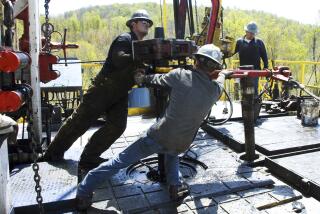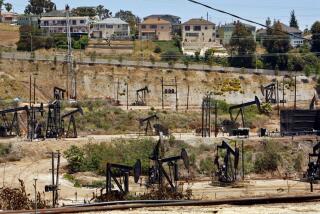The Not-So-Friendly Neighborhood Gas Derricks
FORT WORTH — Across from Trish Kinkade’s home on a winding, residential road here, a natural gas derrick 140 feet high juts into the sky. Behind her backyard is another hulking derrick, and two more are down the road.
“They’re everywhere now, you can’t get away from them,” Kinkade said, crinkling her nose as a chemical smell wafted from a well site. “There’s nothing you can do but put up with it.”
Fort Worth sits atop a massive, gas-dense layer of black rock called the Barnett Shale, and the rush to tap into it is on -- even if that means boring holes in backyards, along roadsides, and near churches, parks and schools. At last count, Fort Worth officials had issued 540 permits for gas wells within city limits.
“It’s a whole new way of life for Fort Worth,” Mayor Mike Moncrief said.
Although oil and gas wells have been drilled in other highly urbanized areas, including Los Angeles, the magnitude of drilling in Fort Worth sets the city apart, said Eric Potter, associate director of the Bureau of Economic Geology at the University of Texas. Elsewhere, gas wells are on “a few percent” of city land, he said, but because the Barnett Shale is believed to be rich with gas throughout, virtually all of Fort Worth has become a drill site. “It’s like shooting fish in a barrel,” Potter said.
Mostly rural counties that surround the city are also in on the bonanza, but it’s in Fort Worth -- where the focus of the drilling moved last year -- that competing interests have repeatedly clashed. Drilling companies and mineral rights owners are eager to extract as much natural gas as possible, as gas prices climb to historic heights. (“If you don’t have a gas well ... Get one!” reads a freeway billboard advertising drilling services.) But suburban homeowners are unhappy about living next to noisy, chaotic drill sites, and city leaders are scrambling to appease both sides.
“We’re used to seeing derricks out in the country and the trucks that are serving those wells 24-7, but we’re not used to seeing that in our city,” Moncrief said. “It’s a challenge to balance the rights of people who own the minerals beneath the property with the need to protect our quality of life in the city.”
Last month, the city passed an ordinance that increased the minimum distance between wells and homes from 300 to 600 feet. The ordinance also requires gas drillers to install noise blankets and other devices to ensure noise levels do not rise more than 5 decibels during the day and 3 decibels at night.
The new rules have done little to placate Don Young, leader of the Fort Worth Citizens Against Neighborhood Drilling Ordinance. “I thought a 3,000-foot buffer was reasonable,” he said, “but there’s no way homebuilders would allow that much land to go undeveloped.”
Drilling natural gas wells in the middle of neighborhoods is insanity, Young said. In addition to environmental, noise and aesthetic issues, he said, the potential danger of an explosion should be enough to prompt second thoughts.
“I’m basically in the position of waiting for a disaster to happen,” Young said. “I think that’s the only thing that will get people to listen, because they aren’t listening now. People are getting filthy rich out of this.”
In April, an explosion at a well site in a southeast Fort Worth neighborhood killed a contractor and forced the evacuation of 500 homes. City and industry officials say that blowouts are rare and that drilling in populated areas is safe and clean. Drillers use a technique that involves going down to the rock, then moving horizontally in multiple directions. Officials say this allows drillers to go under houses without affecting the surface or getting too near homes and schools.
But Gary Hogan and other homeowners who live near drill sites say the process of creating a large gravel drill site, boring into the ground and breaking up rock to release natural gas is loud and disruptive.
Hogan, a member of the task force that worked to change the city ordinance, recalled that his neighborhood on the northwest side of town was “a quiet place in the suburbs. I thought it was beautiful. Then all the sudden a gas well started going up 600 feet from my house.”
Day and night, he said, caravans of heavy trucks carrying water, gravel and equipment jostled down residential streets. The rumbling of drill motors, the clang of metal against metal and a stop-and-go screeching sound drove him to distraction. “I can’t get my mind around the city wanting to build houses around a gas well,” he said.
The well by his house was capped this year, but a developer in a nearby neighborhood is planning to place three drilling sites among 500 homes. Twelve wells will be drilled from the three sites.
“If this keeps up, 10 years from now no one will want to live in this neighborhood, because who wants to live next to a bunch of wells? We’ll look back and say, ‘What were we thinking?’ ” he said.
About a mile away, Scott Willis, 41, lives across the road from a yellow and blue derrick that started going up a few months after he moved here. “No one told us we’d be living next to that,” he said. “I understand the need for natural gas, but I’m concerned about living so near a gas well.”
As gas drillers and large private landowners cash in on the boom, “people don’t seem to be concerned about the citizens,” he said.
The situation is complicated by a Texas law that allows the rights of mineral owners to trump those of surface land owners. If the city tried to stop drilling altogether, “mineral rights owners would go to the state and we’d get sued,” Fort Worth spokesman Jason Lamers said. “It’s not completely up to the city. Everyone needs this gas. We’re walking a fine line trying to protect everyone involved.”
With so much at stake, Kinkade -- her mobile home sandwiched between two drilling towers -- has resigned herself to life among the derricks.
“Just when you think you’re about to drop off to sleep, here comes that noise, whoooop, whoooop or screeee-argh screeee-argh,” Kinkade said, rolling her eyes. “We’re not out in West Texas somewhere, but there’s a derrick right next to your house. It’s hard to believe, but what can you do but just live with it?”
More to Read
Sign up for Essential California
The most important California stories and recommendations in your inbox every morning.
You may occasionally receive promotional content from the Los Angeles Times.










